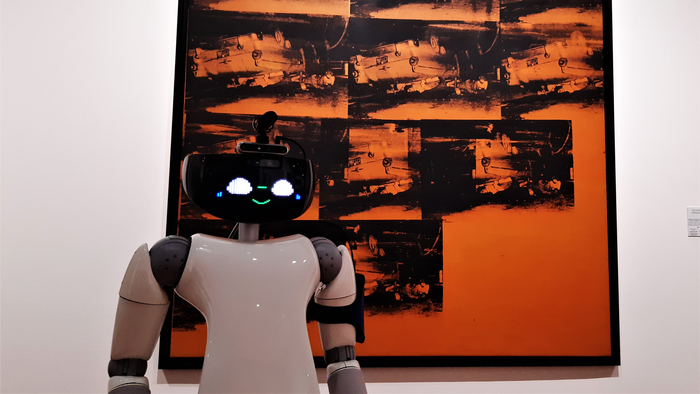
This May 27, 2022 Istituto Italiano di Tecnologia (IIT) press release on EurekAlert offers an intriguing view into the potential for robots in art galleries,
Robotics, 5G and art: during the month of May visitors to the Turin’s art museums, Turin Civic Gallery of Modern and Contemporary Art (GAM) and Turin City Museum of Ancient Art (Palazzo Madama), had the opportunity to be part of various experiments based on 5G-network technology. Interactive technologies and robots were the focus of an innovative enjoyment of the art collections, with a great appreciation from the public.
Visitors to the GAM and to Palazzo Madama were provided with a number of engaging interactive experiences made possible through a significant collaboration between public and private organisations, which have been working together for more than three years to experiment the potential of new 5G technology in the framework of the EU-funded project 5GTours (https://5gtours.eu/).
The demonstrations set up in Turin led to the creation of innovative applications in the tourism and culture sectors that can easily be replicated in any artistic or museum context.
In both venues, visitors had the opportunity to meet R1, the humanoid robot designed by the IIT-Istituto Italiano di Tecnologia (Italian Institute of Technology) in Genova and created to operate in domestic and professional environments, whose autonomous and remote navigation system is well integrated with the bandwidth and latency offered by a 5G connection. R1, the robot – 1 metre 25 cm in height, weighing 50 kg, made 50% from plastic and 50% from carbon fibre and metal – is able to describe the works and answer questions regarding the artist or the period in history to which the work belongs. 5G connectivity is required in order to transmit the considerable quantity of data generated by the robot’s sensors and the algorithms that handle environmental perception, autonomous navigation and dialogue to external processing systems with extremely rapid response times.
At Palazzo Madama R1 humanoid robot led a guided tour of the Ceramics Room, while at GAM it was available to visitors of the twentieth-century collections, accompanying them to explore a selection of the museum’s most representative works. R1 robot explained and responded to questions about six relevant paintings: Felice Casorati’s “Daphne a Pavarolo”, Osvaldo Lucini’s “Uccello 2”, Marc Chagall’s “Dans mon pays”, Alberto Burri’s “Sacco”, Andy Warhol’s “Orange car crash” and Mario Merz’s “Che Fare?”.
Moreover, visitors – with the use of Meta Quest visors also connected to the 5G network – were required to solve a puzzle, putting the paintings in the Guards’ Room back into their frames. With these devices, the works in the hall, which in reality cannot be touched, can be handled and moved virtually. Lastly, the visitors involved had the opportunity to visit the underground spaces of Palazzo Madama with the mini-robot Double 3, which uses the 5G network to move reactively and precisely within the narrow spaces.
At GAM a class of students from a local school were able to remotely connect and manoeuvre the mini-robot Double 3 located in the rooms of the twentieth-century collections at the GAM directly from their classroom. A treasure hunt held in the museum with the participants never leaving the school.
In the Educational Area, a group of youngsters had the opportunity of collaborating in the painting of a virtual work of art on a large technological wall, drawing inspiration from works by Nicola De Maria.
The 5G network solutions created at the GAM and at Palazzo Madama by TIM [Telecom Italia] with Ericsson technology in collaboration with the City of Turin and the Turin Museum Foundation, guarantee constant high-speed transmission and extremely low latency. These solutions, which comply with 3GPP standard, are extremely flexible in terms of setting up and use. In the case of Palazzo Madama, a UNESCO World Heritage Site, tailor-made installations were designed, using apparatus and solutions that perfectly integrate with the museum spaces, while at the same time guaranteeing extremely high performance. At the GAM, the Radio Dot System has been implemented, a new 5G solution from Ericsson that is small enough to be held in the palm of a hand, and that provides network coverage and performance required for busy indoor areas. Thanks to these activities, Turin is ever increasingly playing a role as an open-air laboratory for urban innovation; since 2021 it has been the location of the “House of Emerging Technology – CTE NEXT”, a veritable centre for technology transfer via 5G and for emerging technologies coordinated by the Municipality of Turin and financed by the Ministry for Economic Development.
Through these solutions, Palazzo Madama and the GAM are now unique examples of technology in Italy and a rare example on a European level of museum buildings with full 5G coverage.
The experience was the result of the project financed by the European Union, 5G-TOURS “5G smarT mObility, media and e-health for toURists and citizenS”, the city of Turin – Department and Directorate of Innovation, in collaboration with the Department of Culture – Ericsson, TIM [Telecom Italia], the Turin Museum Foundation and the IIT-Istituto Italiano di Tecnologia (Italian Institute of Technology) of Genova, with the contribution of the international partners Atos and Samsung. The 5G coverage within the two museums was set up by TIM using Ericsson technology, solutions that perfectly integrated with the areas within the two museums structures.
Just in case you missed the link in the press release, you can find more information about this European Union Horizon 2020-funded 5G project, here at 5G TOURS (SmarT mObility, media and e-health for toURists and citizenS). You can find out more about the grant, e.g., this project sunset in July 2022, here.